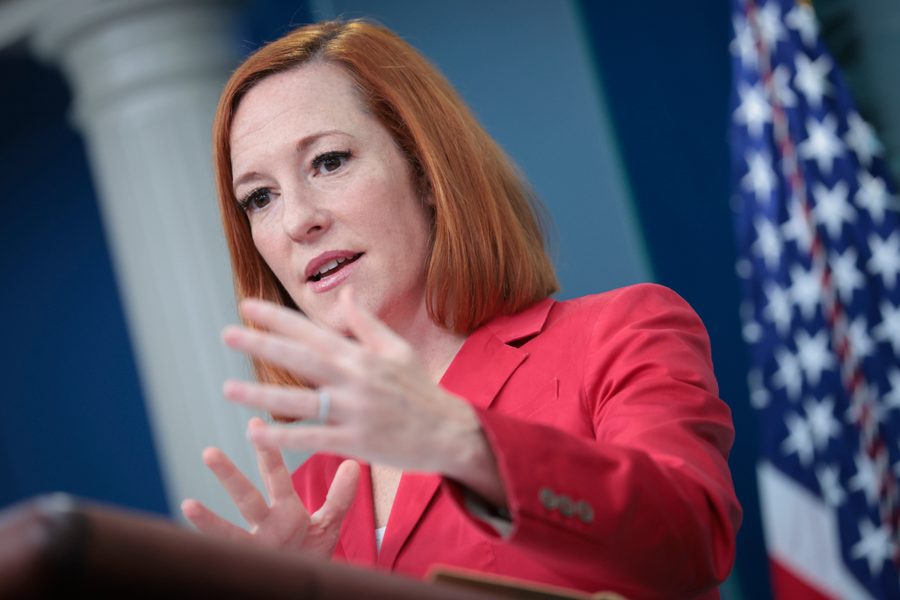The Existential Danger of Using the Ukraine Invasion to Ramp Up Fossil Fuel Production
Just as scientists warn we must drastically shift away from fossil fuel extraction, the Biden administration is pressing for more oil production.
Sarah Lazare

As Russian President Vladimir Putin escalates his horrific invasion of Ukraine, in which civilians are being mowed down as they attempt to flee to safety, the Biden administration is now arguing that the United States can counter Putin’s aggression by pursuing more oil production, both domestically and among U.S. allies. Citing increased production as a path to more “energy security,” President Biden has also retreated from any robust discussion of tackling climate change — an orientation that shows how war can harden reactionary, short-sighted politics across the globe. Just as the world’s top scientists warn in a dire new report from the Intergovernmental Panel on Climate Change (IPCC) that we must dramatically curb fossil fuel extraction, political leaders are allowing for even less breathing room to discuss an existential threat that could kill hundreds of millions of people, and make large swaths of the globe uninhabitable.
U.S. gas prices are rising, due to the role global sanctions are playing in hampering Russia’s ability to export crude oil (despite carve-outs for fossil fuels). Right-wing commentators and politicians, meanwhile, have been circulating a talking point that the Biden administration’s supposed “war” on the oil and gas industry has made Russian fossil fuels more valuable, and therefore empowered Putin to invade Ukraine. As climate journalist Kate Aronoff recently pointed out, fossil fuel executives are taking advantage of this political environment to “push through a rash of new fossil fuel infrastructure that will stay online for decades to come, continuing to pollute.”
The Biden administration has responded by assuring the public that U.S. oil and gas production remains robust. On March 6, White House Press Secretary Jen Psaki took to Twitter to proclaim that, “U.S. production of natural gas and oil is rising and approaching record levels: More natural gas than ever this year, more oil than ever next year, and, even with a global pandemic, more oil production this past year than during the previous administration’s first year.”
In that same thread, the press secretary made a small gesture toward the necessity of a “green” approach to energy security: “Production is up, rising, and approaching records, yet Russia’s actions still leave our consumers vulnerable. It’s a reminder that real energy security comes from reducing our dependence on fossil fuels.”
This dual message — that the United States is both pursuing more fossil fuel extraction while acknowledging such extraction must be reduced — has been replete throughout the Biden administration’s messaging. Yet, it is the first half of this assertion — that extraction must increase — which has most been acted upon by the Biden administration. Federal data analyzed by Center for Biological Diversity, an environmental organization, shows that the Biden administration has approved 34% more oil and gas drilling permits on federal land than former President Trump did in his first year in office. President Biden did temporarily halt new federal leases, before a judge ruled against the decision in June. But, as Rebecca Leber explains for Vox, “the president has done nothing to prevent the vast amount of gas production that occurs on private lands or halt existing oil leases on federal lands.”
All of these trends were in place well before Putin invaded Ukraine, though the president did announce in December that he was stopping federal support for overseas carbon-intensive projects, like coal plants (an announcement that has been the target of right-wing pushback). Yet, the Biden administration is now presenting the president’s inaction on his climate promises as part of a strategy to achieve “energy security” in the face of Russia — a strategy that requires more fossil fuel extraction.
In a fact sheet about sanctions on Russia released on March 2, the White House proclaims that “the United States and our Allies are acting in concert to minimize the impact of these measures on our economies, including through a coordinated release of 60 million barrels of oil from strategic reserves.”
This emphasis has been accompanied by a significant abandonment of strong climate rhetoric. As Aronoff puts it, climate concerns “are on the back burner compared to just a few months back” when the world was focused on the COP26 negotiations. In his March 1 State of the Union address, the president only mentioned climate change twice, and each was a passing, superficial reference. Meanwhile, Biden doubled down on his pledge to increase oil production: “Tonight, I can announce that the United States has worked with 30 other countries to release 60 million barrels of oil from reserves around the world,” he said. “America will lead that effort, releasing 30 million barrels from our own Strategic Petroleum Reserve. And we stand ready to do more if necessary, unified with our allies.”
Biden’s flagship Build Back Better act, already stripped of its most impactful climate provisions, has been further sidelined as the crisis in Ukraine continues to spiral. That legislation would still make investments in climate mitigation strategies, but has faced pushback from conservative Democrats such as Sen. Joe Manchin (D-W.Va.) and remains stalled in Congress.
Biden is also reportedly considering sending officials on another trip to Saudi Arabia to encourage the monarchy to increase oil production. The revelation generated immediate criticism, given that Saudi Arabia, with U.S. help, is waging a brutal war against Yemen that has led to the world’s worst humanitarian crisis and killed almost a quarter million people. In February, concerned about Russian actions toward Ukraine, the Biden administration dispatched two high-ranking officials to Saudi Arabia to hold similar discussions about increasing oil production.
Of course, rising gas prices do pose immediate concerns, particularly for poor people who need access to affordable heat and electricity. “This is a tough one, because folks in Europe are not through winter yet and have been cut off from a supply they usually use,” says Lindsay Koshgarian, the program director of the National Priorities Project, which researches U.S. military spending. “There isn’t another immediately available form of heat. Obviously they needed to have transitioned to renewables yesterday, like all of us.”
But this immediate material concern should not mean that discussion of climate change goes out the window, given that it, too, is an immediate, material threat that is already claiming lives, particularly among the world’s most vulnerable. The IPCC, made up of top climate experts convened by the United Nations, warned in a major report released February 28 that from 2010 to 2020, people in vulnerable countries — Mozambique, Somalia, Nigeria, Afghanistan and Haiti — had a mortality rate from “floods, droughts and storms” that was 15 times that of less vulnerable, more wealthy nations. Shouldn’t these lives factor in when we consider the human toll of any policy decisions that emerge from the war? The hardships of those facing heat and energy insecurity should not be dismissed, but neither should the hardships of those facing drought and famine.
Koshgarian tells In These Times that the Biden administration is mostly talking about producing more fossil fuels, “when really this could be an opportunity to do the bare minimum necessary to tide over the folks in Europe through the crisis, but really to jump start an energy transition. But they are not approaching it that way at all. They are talking about releasing new stores of fossil fuels. The focus has gone almost completely off of climate change. There is no air in the room left for climate change at the moment.”
The latest IPCC report warned that climate change is progressing so severely and rapidly that, if fossil fuel extraction isn’t radically reduced, humanity will not be able to adapt to extremes in storms and heat. More than 13 million people in Asia and Africa were displaced by extreme weather in 2019, and about half of the global population has faced a water shortage for some portion of the year. The 270 researchers from 67 countries found that 40% of people in the world are “highly vulnerable” to climate change. In the words of Professor Debra Roberts, co-chair of the IPCC, “Our report clearly indicates that places where people live and work may cease to exist, that ecosystems and species that we’ve all grown up with and that are central to our cultures and inform our languages may disappear.”
Some critics argue that a transition away from fossil fuels could help curb Putin’s aggression, given the role of Ukraine as a transit route for Russian oil and gas,r that such a shift could curb the violence of U.S. allies like Saudi Arabia (or the United States, for that matter, given the role oil has played in contributing to U.S. wars of aggression). There is a strong case to be made, meanwhile, that military buildup and war are extremely bad for the climate, and that truly tackling the climate crisis requires a dramatic shift away from perpetual militarism.
But these geopolitical concerns aside, it’s clear that an aggressive effort to curb fossil fuel use is required to safeguard the whole of human society. If we are concerned about protecting the innocent and aiding the suffering, we must not allow Russia’s violent invasion to further entrench another ghastly and large-scale human crime.
“The climate crisis is happening faster, more widespread, and more intensely than scientists originally predicted,” says Adrien Salazar, policy director for Grassroots Global Justice Alliance, a social movement organization. “And we are in a period where any further delay means death, as UN Secretary General António Guterres said.”
The shift in the Biden administration’s language is particularly alarming because the United States is disproportionately responsible for climate harms. “The rich countries of the global North are responsible for the vast majority (92%) of the cumulative emissions in excess of the safe planetary boundary of 350ppm — in other words, the emissions that are causing climate breakdown,” says Jason Hickel, an economic anthropologist, author and a fellow of the Royal Society of Arts. “Scholars have long recognized this as a process of atmospheric colonization.”
According to an analysis authored by Hickel, as of 2015, the United States was responsible for 40% of “excess global carbon dioxide emissions,” when historic emissions are considered.
As Hickel puts it to In These Times, “Climate breakdown is a form of violence. Those who are least responsible are most affected. It would be difficult to overstate the scale of this injustice.”
Sarah Lazare is the editor of Workday Magazine and a contributing editor for In These Times. She tweets at @sarahlazare.








